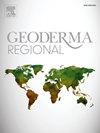高寒冻土带土壤呼吸控制
IF 3.1
2区 农林科学
Q2 SOIL SCIENCE
引用次数: 0
摘要
由于气候因素抑制微生物活动,高寒苔原生态系统与北极生态系统一样,在历史上一直是土壤有机碳(SOC)储存的重要场所。虽然气候因素是重要的,但异位土壤呼吸(和有机碳储量)可能受到一系列土壤特征的影响。在这项研究中,我们于2015年6月至2021年9月在美国科罗拉多州落基山国家公园的4个高山冻土带站点测量了土壤呼吸、土壤温度、土壤水分、土壤养分浓度、土壤pH和土壤质地。我们还使用地理空间模型来可视化预测该系统在21世纪的气候变化。最后,我们测量了七年研究期间的有机碳浓度。研究发现,土壤呼吸与土壤温度、土壤湿度和土壤质地呈显著相关。其他参数均与土壤呼吸无显著相关。我们还发现,在七年的研究过程中,有机碳浓度没有显著变化。预测模型显示,到本世纪末,在公园的大部分地区,平均最高气温将升高,降雪量将减少,土壤湿度将减少,无雪日数将增加。这些结果表明,SOC目前并未以高速率从该系统中丢失。此外,在气候变化的情况下,土壤呼吸可能随着气候变暖而增加,但总体增加可能受到土壤水分减少和某些情况下土壤温度升高的限制。本文章由计算机程序翻译,如有差异,请以英文原文为准。
Controls on soil respiration in alpine tundra
Alpine tundra ecosystems, like their arctic counterparts, have historically been the sites of considerable soil organic carbon (SOC) storage due to climatic factors that suppressed microbial activity. While climatic factors are important, heterotopic soil respiration (and SOC storage) may be influenced by a range of soil characteristics. In this study, we measured soil respiration, soil temperature, soil moisture, soil nutrient concentrations, soil pH, and soil texture in 4 alpine tundra sites located in Rocky Mountain National Park, Colorado, USA from June 2015 – September 2021. We also used geospatial modeling to visualize predicted climate changes in this system over the 21st century. Finally, we measured SOC concentrations over the seven-year study. We found that soil respiration was significantly correlated with soil temperature, soil moisture, and soil texture. All other parameters were not significantly correlated with soil respiration. We also found that SOC concentrations did not change significantly over the course of the seven-year study. The predictive models show that by the end of the century, over the majority of the park, the mean maximum air temperature will increase, the amount of snowfall will decrease, soil moisture will decrease, and the number of snow-free days will increase. These results suggest that SOC is not currently being lost from this system at a high rate. In addition, it appears that with a changing climate, soil respiration may increase with warming, but the overall increase may be limited by decreased soil moisture and in some cases, high soil temperatures.
求助全文
通过发布文献求助,成功后即可免费获取论文全文。
去求助
来源期刊

Geoderma Regional
Agricultural and Biological Sciences-Soil Science
CiteScore
6.10
自引率
7.30%
发文量
122
审稿时长
76 days
期刊介绍:
Global issues require studies and solutions on national and regional levels. Geoderma Regional focuses on studies that increase understanding and advance our scientific knowledge of soils in all regions of the world. The journal embraces every aspect of soil science and welcomes reviews of regional progress.
 求助内容:
求助内容: 应助结果提醒方式:
应助结果提醒方式:


